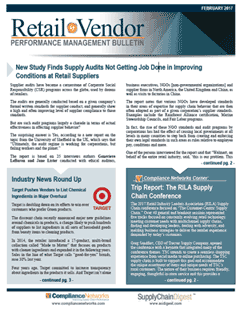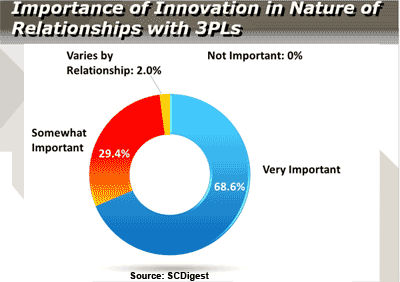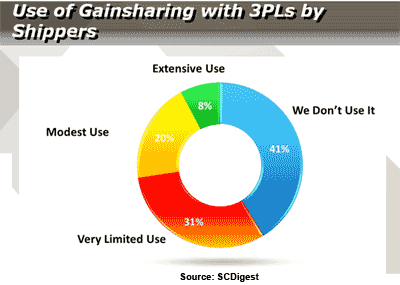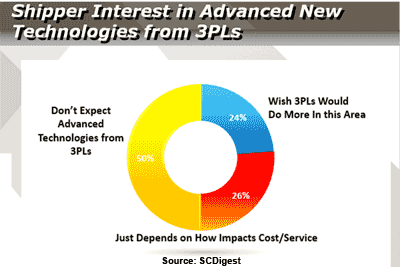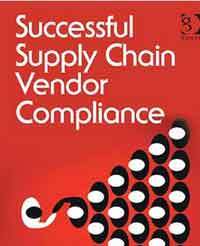 |
March 9, 2017 - Supply Chain Flagship Newsletter |
 |
| FEATURED SPONSOR: PROMAT |
||
Register Now for the 2017 Promat Conference |
||
 |
|
|||||||||||||||||||||||||||||||||||||||||||||||||||||||||||||||||||||||||||||||||||||||||||||||||||
|
||||||||||||||||||||||||||||||||||||||||||||||||||||||||||||||||||||||||||||||||||||||||||||||||||||
Some of the comments were very interesting.
|
||||||||||||||||||||||||||||||||||||||||||||||||||||||||||||||||||||||||||||||||||||||||||||||||||||
Why is that? I am not sure. My friend the late Ken Miesemer believed deeply in gainsharing while running logistics for Hershey Foods, for example. It seems obvious to me innovation would be limited if the 3PL does not have a way to benefit from process or technology improvement. There were decidedly mixed results here. As seen below, 50% of shippers don't expect these advanced technologies from 3PLs, while about one in four want 3PLs to do a lot more in this area. About another 25% say it depends on the 3PL and the situation, which is probably the right answer.
|
||||||||||||||||||||||||||||||||||||||||||||||||||||||||||||||||||||||||||||||||||||||||||||||||||||
I'll note a few 3PLs, notably DHL, have in fact been very aggressive with some of these new technologies, seemingly to their benefit. For example, DHL seems to actually be the leader across shippers or 3PLs in advancing the use of smart glasses in distribution center applications. What are your thoughts on innovation between shippers and 3PLs? Are contracts a major issue? Let us know your thoughts at the Feedback button or section below. |
||||||||||||||||||||||||||||||||||||||||||||||||||||||||||||||||||||||||||||||||||||||||||||||||||||
|
||||||||||||||||||||||||||||||||||||||||||||||||||||||||||||||||||||||||||||||||||||||||||||||||||||
|
||||||||||||||||||||||||||||||||||||||||||||||||||||||||||||||||||||||||||||||||||||||||||||||||||||
|
|
|
YOUR FEEDBACK
Ok, some of this is a bit dated, but there was lots of all the Feedback on Gilmore's First Thoughts column on The Trump Supply Chain? and then Readers Respond - The Trump Supply Chain we never had room for in the e-magazine, and thought it would be fun this week to publish a few more a month plus into the Trump administration, so
here you go. All great Feedbacks.
Feedback on The Trump Supply Chain
![]()
Without knowing what Donald Trump has planned for the global supply chain in the way of Trade Agreements and tariff manipulation, the fact is that the impact of technology on the American blue collar workers and those white collar workers that are impacted by technology has been devastating.
It is widely reported that for every manufacturing job lost to off-shore manufacturing, 7-8 jobs are lost to robotics or other technologies - See Fortune article. This trend will only continue and exacerbate what is incorrectly being attributed to off-shore low cost manufacturing.
The potential negative impact of the Trump administration incorrectly diagnosing the problem can lead to catastrophic trade policy which can have devastating impact on industry and the consumer. The imposition of punitive tariffs can draw unexpected retaliatory measures that can directly lead to lost export sales, higher landed costs and resulting consumer prices, rise in inflation, higher interest rates, reduced disposable income for the middle and lower economic earners, etc. The cascading effect is potentially huge.
Ned Blinick
Chief Product Officer
Blinco System Inc.
![]()
You got some great feedback. I've heard Patrick Lemoine's argument from many people. Consumers want low cost goods. So, which came first? Low price desires? Or, did the desire for low cost goods depress employment and wages in the U.S. to the point where that 'desire' became a necessity? Remember, Wal-Mart was founded on 'Buy American'. Like many Americans, I have personally taken an over seventy percent drop in income since 2006. And that's income that was commission and profit margin based. Yes, my former employer continually cut commissions to increase profits. But, as retail prices dropped, and profit margins shrank in what has become a bit of a mature industry, all of the 'old timers' have told the same story. And, as this technology has become more 'plug and play' the sales forces selling it have become order takers.
Sadly, as profit margins shrink, the push for innovation and research also suffers. My Brother-in-law worked for Dell in the early days. One of the big parts of their success was an entire team devoted to product innovation and competitive positioning. But, you know that. You've showcased how Dell does things right on your webcasts.
Shelley Jordan hit the nail on the head about Chinese dumping of products here. Sato has done it with printers. The reverse is true as well. South American scanner and POS equipment prices are lower to distributors there, than on the exact same equipment sold in the U.S. I had international customers who bought from BlueStar's Miami office, and shipped into the U.S. locations because they could buy at lower prices as a South American, or European, 'customer'.
Jerry Salzman's comment that Pfizer thinks people are making more of this than is there, ignores the fact that the drug manufacturers are extremely profitable, and have patent protections which protect those profits. Pfizer, and Lilly, have been customers of mine for thirty years. Both in safety equipment, and barcode equipment. I did a project for Lilly a few years ago where they could easily cut the cost of a custom system from 70K to 25K per workstation. I pointed out the waste, and the fact that the added costs gained them nothing, and the engineers agreed. But, they replied "We don't care. We've got so much profit in this product, it doesn't matter." I'm sure you remember Gibson Greeting Cards. They too, bragged about the profit they had in their cards, which supported multiple levels of redundant management. They're gone.
Manufacturing may have crashed and burned in the U.S., but distribution is still needed. I think the companies that provide hardware, software, and the expertise to automate this portion of the supply chain beyond its current handheld and forklift technology will be the ones that will survive. (I won't go so far as to say thrive just yet.)
When I started in the business, barcode printers sold for over 3,500.00. Now there are printers that do more for 395.00. As with all technology, price drops, and products improve. Automation has, and will continue to replace workers. I currently have two projects totaling 400 - $500,000.00 where the U.S. Manufacturers (and I), may lose out to $200.00 Android smart phone style terminals as one of the possible equipment choices. Even one of our South Korean manufacturers cannot beat that price.
I still say that (at least here in Ohio), the line I told one of the founders of General Data in the early nineties still holds. "There are no new plants being built. The business we're going to get, is going to be business that we take away from someone else." (Fortunately, since then, there's been a bit of new DC activity in places like West Chester, Columbus, and N. Kentucky). I sold safety equipment to the coal mines. Their only way out of coal is to have subsidies which put the industries of high tech manufacturers right in the area. As one of your responders mentioned. Even if measures are taken to 'help' the industry, technology, and the low price of natural gas, make the prospect of many jobs returning very slim.
I think I mentioned my former safety equipment company. Boss Manufacturing. To get around U.S. content requirements. we would have products that were made in our plant in Mexico, packaged, or some minor assembly done here in the U.S., so we met the U.S. auto manufacturers made in the U.S. minimum content requirements to be considered as a supplier. We also had product shipped from China to Mexico, and into the U.S. which also qualified as 'U.S. content' by doing so. In the late seventies, our U.S. production plants were paying union workers 17.00 to 20.00 an hour. All of that production was moved to Juarez, Mexico, where workers were paid 2.00 an hour.
Side story: I sold safety equipment to the Norwood Chevy plant near Cincinnati. As you may have guessed, I was one of those 'How about this?' kind of vendors. I happened to be in our Dayton office one day when an importer of a glove they used called to say a deal had fallen through, and he had to unload container loads that were exactly like one GM used. I had the GM business, and they could have saved 300,000K with this 'special deal'. I called the purchasing manager, and he replied that it would be "too much trouble to create a new part number in the system to reflect the discounted price", on a product they were already buying. They're closed.
And, while I'm rambling, all of my competitors and co workers commiserate about another phenomena we've seen over the years. As companies cut staff, people are less likely to have the time, or the inclination, to try new things. As my boss at Lowry used to say to buyers who were considering a less expensive, or lesser known, 'alternative' when our offering was a more expensive Zebra printer, he would reply, "You know. It's not your money. But, it could be your job." These days, buyers are scared to try new things because they don't want to draw attention to themselves if it fails. Or, they're wearing so many hats, they simply don't have the time. I did projects with Verizon worth millions. One day I got a call from a VP I almost never spoke with. I said "Wow. I feel really privileged. I hardly ever get to talk to you." He replied "Don't get too excited. They've let most of the people under me who were handling this project go, so now you're stuck with me."
Your dedication, and the delight in your webcasts and reports shines through. You get it. You're still the 'kid in the candy store'. You are the Cliff's Notes version of industry education for those people who really do want to be informed. That enthusiasm, and additional knowledge, just might be the thing that moves them from a point of complacency, or being overwhelmed, to one of, Hey! Lets seriously consider something.
Bob McIntyre
National Account Executive
DBK Concepts, Inc.

![]()
Thank you for including my feedback in the responses to your great article. I am a she not a he, but that is ok because I am use to being called one of the guys since I play basketball (well I am worn out now) and work with men all the time. [Note from SCDigest - sorry about that!]
In response to latest:
I do believe Trump will have success in supply chain in manufacturing because he never quits, he is intelligent and he is working hard on getting teams together. He really does want to make America great again. Why would Trump risk his life and company to run for president if he did not believe he could accomplish great things. I believe he has been planning things out for years. Since he has Trump towers all over the world (global), he has more global business knowledge than most realize. He may not be a supply chain guru, but I believe he is wise enough to hire one or more to accomplish projects.
Overall, in terms of the manufacturing, yes manufacturing will revive in America but it will start off slowly. The manufacturing that will first revive may be steel and then other types that have very few parts. The more parts (skus) that are required to manufacture a product the more difficult it will be to bring the manufacturing back to America because the parts may come from many different foreign locations and take so much time to create a mass manufacturer for the parts in the USA for a low enough cost.
I believe the most difficult ones are with electronic and computer parts. The bad thing is that the quality we receive these days in electronics and computers is about 30% of what we use to get when it was made here in USA. However, the price with inflation is not 30%, it is at least 50%. So why are we Americans buying this junk?
Just to let YOU know I worked as a subcontractor under KPMG in 2000 as the supply chain strategy expert for Apple Computer when there stock was dropping daily and they didn't know if they were going to survive. So it was a panic attack environment. They changed there minds weekly. They still wanted to create a strategy for 5, 10, 15 and even 20 years. They gave us code names for there future products. The interesting part is there intention was to always manufacture completely in USA with USA parts for high quality. None of us had a clue how quickly manufacturing would leave America. The interesting thing is that I have a MacBook of 2008 that is the last version with no Chinese parts. So it is 8 years old and I have never had a problem with it. Now today, for the same price they last 2-3 years due to the Chinese parts. Now why do we Americans agree to this nonsense? Do we just like to waste money and have unemployment? That equation just doesn't make sense.
Something that does make sense is this:
1. Capitalism is the same thing as competition but you don't have to use the word capitalism, it's just a statement I am making.
People love to compete and don't want to be losers. The inner cities can compete for new business by attracting the business by working together and using their gifts to improve the area to be attractive, be ready to work and be trained to work, have the right attitude, fight crime, educate not just the students but the adults that want to work and more. There are people that are doing this to help already.
2. Businesses can decide if they want to mfg here or not, if so if they want to at reduced cost and get a tax break then they go to inner city where there is also great interstate connections. Also, there will be empty large buildings easy to get ready. Then it takes time and patience for training for each task. So you have upper management and mid mgt, but then the rest can be trained from the inner city which can include security. When you give people a purpose and you pay them and they are making a difference in the economy, their entire attitude shifts. Also, if you use industrial engineering methods, the business will be outstanding. So when this starts and one business or groups of businesses in a city is successful then other cities will say "hey we can clean up better than that and get more business".
It's all about competition.
Something starts that gets people interested and then it grows. That is what happened with cheaper products when the economy was down and people bought the cheaper products and did not even realize at first the products were from China or realize that it mattered. Given this fact, retailers competed with cheaper products over time so the manufacturers here lost business and moved overseas or closed.
So what needs to be done in America is start something new that gets people excited and even makes them want to get involved. So that is what I am talking about with the manufacturing in the inner cities.
So when USA products are made by people that were unemployed and living in poverty, I do believe that will start excitement in our country. More companies will follow the same path and people will want to buy the USA products even if they cost more, especially if Quality is emphasized!!
Additionally, retailers can also collaborate and have hubs in the inner cities to save on inventory, transportation, labor, systems, and back haul costs and more. This could also be a way for retailers to compete with Amazon by having hubs close to residents for overnight shipping. - more competition
This is another way of decreasing unemployment and possibly the retail cost of the product.
Thank you for your time and great work!
God Bless America!
Shelley Jordan
Industrial & Supply Chain Engineer / Consultant and Inventor plus more
Synergy Solutions Group

SUPPLY CHAIN TRIVIA ANSWER
Q: What were what we now call ocean shipping containers called when they were first introduced in 1956?
A: Trailer vans.
| © SupplyChainDigest™ 2003-2017. All Rights Reserved. SupplyChainDigest PO Box 714 Springboro, Ohio 45066 |
POWERED BY: XDIMENSION
|







